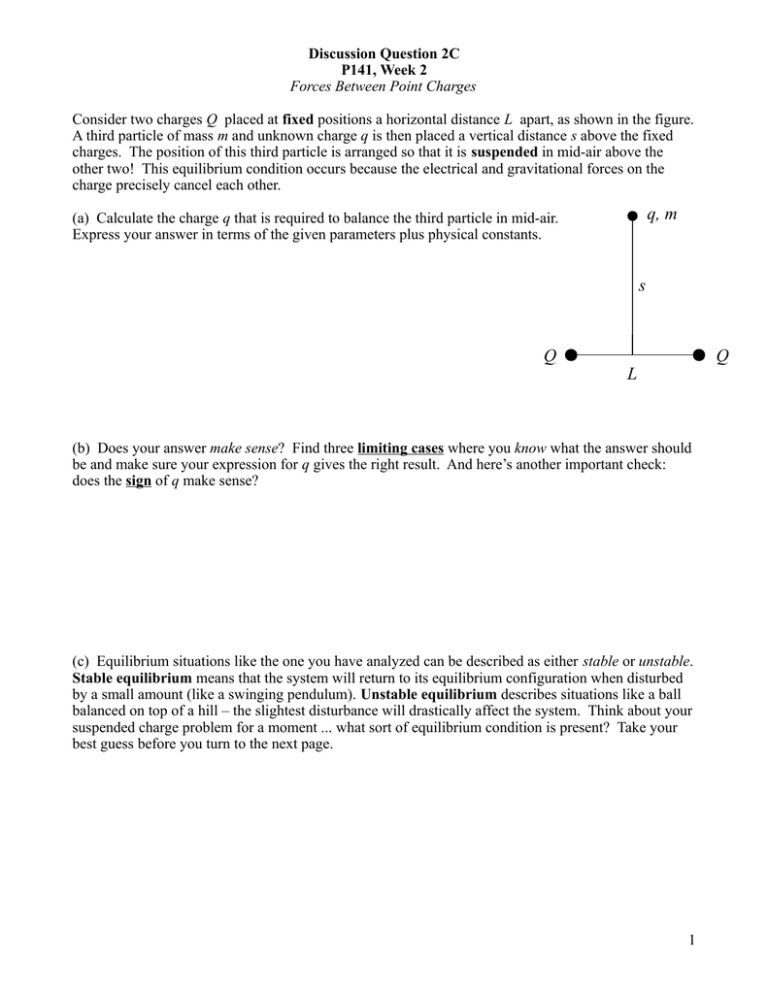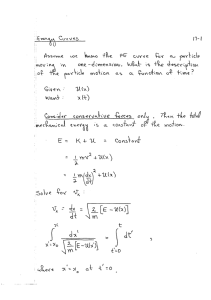Consider two charges Q placed at fixed positions a horizontal
advertisement

Discussion Question 2C P141, Week 2 Forces Between Point Charges Consider two charges Q placed at fixed positions a horizontal distance L apart, as shown in the figure. A third particle of mass m and unknown charge q is then placed a vertical distance s above the fixed charges. The position of this third particle is arranged so that it is suspended in mid-air above the other two! This equilibrium condition occurs because the electrical and gravitational forces on the charge precisely cancel each other. q, m (a) Calculate the charge q that is required to balance the third particle in mid-air. Express your answer in terms of the given parameters plus physical constants. s Q Q L (b) Does your answer make sense? Find three limiting cases where you know what the answer should be and make sure your expression for q gives the right result. And here’s another important check: does the sign of q make sense? (c) Equilibrium situations like the one you have analyzed can be described as either stable or unstable. Stable equilibrium means that the system will return to its equilibrium configuration when disturbed by a small amount (like a swinging pendulum). Unstable equilibrium describes situations like a ball balanced on top of a hill – the slightest disturbance will drastically affect the system. Think about your suspended charge problem for a moment ... what sort of equilibrium condition is present? Take your best guess before you turn to the next page. 1 Stable equilibrium means that if you “bump” the charge, the system will provide a restoring force to bring it back to its resting place. In the opposite case of unstable equilibrium, the system will encourage the displacement, forcing the charge further away from its equilibrium spot. So let’s try bumping our suspended charge in different directions … Note: for the graphs below, we are taking the equilibrium height s of the charge to be 1 meter.1 y q, m s Q Q x (d) Is the balanced charge stable against displacements in y? If you bump the charge in the y direction (up or down), will the combined forces of gravity and electricity provide a restoring force, or will they push it further away? Check your physical intuition, then consult the plot at right which shows the vertical component Fy of the force as a function of y. (Note how the force goes to zero at the equilibrium spot y = s = 1 m, as it must … but here we’re concerned with the behavior of Fy around this point.) (e) Is the balanced charge stable against displacements in x? y Again, check your intuition, then the plot. This time it shows the horizontal component Fx of the force as a function of x (while y is kept at s). q, m s Q Q x So are we done? ………… not quite, remember that our charges live in 3-dimensional space! 1 For the record, the other parameters used to produce these plots are L = 2 m, m = 3 g, Q = +2.5 C, and q = 1.85 C. 2 (f) Is the balanced charge stable against displacements in z? Now the plot shows Fz versus z … does this plot show a restoring force? Does it make sense? Q y q, m s Q x Wrapup: z If all went well on the previous page, you found that your suspended charge is stable against displacements in the x and y directions, but not in z. It’s challenging to think in 3 dimensions! We worked with force plots on the previous page, but the potential energy map U(x,y,z) of a system is a much better way to visualize its behavior. Remember from Physics 140 how a system always wants to minimize its potential energy? That means that wells in the potential energy distribution indicate places of stable equilibrium – places where the system wants to be. Below are three plots showing the map U(x,y,z) for your suspended charge (you’ll find out how to calculate them next week). Notice how clear the conditions of stable and unstable equilibrium are! 3



